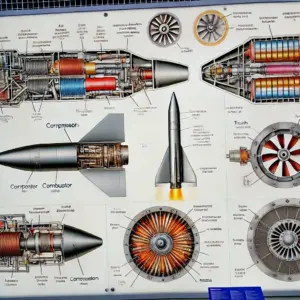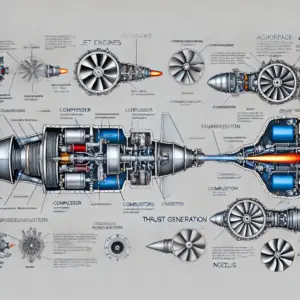Download Aerospace Propulsion Notes pdf – AP Notes Pdf file
Here you can download the free lecture Notes of Aerospace Propulsion Notes PDF (AP Notes Pdf) materials with multiple file links to download. This Aerospace Propulsion Pdf Notes – AP Pdf Notes book starts with the topics covering Introduction to Propulsion, Performance Parameters, Propulsion is a systems endeavor, Integral Momentum Theorem, Application of the Momentum Equation to an Aircraft Engine, Overall Efficiency, Thermal and Propulsive Efficiency, etc.

Aerospace Propulsion Pdf Notes – AP Pdf Notes file to download are listed below please check it
Note: These notes are according to the R09 Syllabus book of JNTU. In R13 and R15, 8-units of R09 syllabus are combined into 5-units in R13 and R15 syllabus. If you have any doubts please refer to the JNTU Syllabus Book.


Overview of Aerospace Propulsion Notes PDF
In this article, we’ll dive deep into the detailed lecture notes for Aerospace Propulsion (AP) provided by JNTU, covering essential topics such as propulsion systems, performance parameters, efficiencies, rocket performance, and much more. These notes are tailored according to the R09 syllabus, which is further condensed into 5 units in the R13 and R15 syllabus.
Links to Download Aerospace Propulsion Notes PDF
AP Complete Notes
1st Unit Notes
2nd Unit Notes
3rd Unit Notes
4th Unit Notes
5th Unit Notes
6th Unit Notes
7th Unit Notes
8th Unit Notes
9th Unit Notes
Aerospace Propulsion Notes and Study Material PDF Free Download
These notes are essential for anyone pursuing a degree in aerospace engineering, providing a comprehensive understanding of propulsion systems and their applications in aircraft and rockets. The study material is curated to facilitate easy understanding and thorough knowledge of the subject matter.
Topics Covered in This Aerospace Propulsion Notes PDF
- Introduction to Propulsion: Fundamentals and importance of propulsion systems in aerospace engineering.
- Performance Parameters: Key metrics to evaluate propulsion system efficiency and effectiveness.
- Integral Momentum Theorem: Application in different propulsion scenarios.
- Application of the Momentum Equation to Aircraft Engines: Detailed analysis and examples.
- Overall Efficiency: Calculations and implications for engine design.
- Thermal and Propulsive Efficiency: Insights into improving engine performance.
- Aircraft Performance: Analyzing drag, power requirements, and flight dynamics.
- Rocket Performance: Understanding thrust, specific impulse, and the Rocket Equation.
- Rocket Nozzles: Design and performance analysis.
- Propeller Thrust Production: Integral Momentum Theorem application and dimensional analysis.
- Ideal Cycle Analysis of Gas Turbine Engines: Efficiency and work calculations.
- Energy Exchange with Moving Blades: Turbine and compressor dynamics.
Aerospace Propulsion Notes PDF from JNTU
These notes are specifically tailored to meet the curriculum requirements of JNTU, offering in-depth coverage of the necessary topics and concepts in aerospace propulsion.
Always Choose Smartzworld to Download Aerospace Propulsion Notes PDF
Smartzworld provides reliable and easily accessible notes and study materials for a variety of subjects. Ensure you have the best resources at your disposal for your studies.
DOWNLOAD NOW
Benefits of FREE Aerospace Propulsion Handwritten Notes PDF
- Comprehensive Coverage: Detailed notes covering all essential topics.
- Easy to Understand: Simplified explanations and examples.
- Accessible Anytime: Downloadable PDF format for convenience.
- Cost-Effective: Free resources to support your education.
Detailed Breakdown of Topics Covered in Aerospace Propulsion Notes
Unit 1: Introduction to Propulsion
The first unit introduces the basic principles of propulsion, laying the foundation for understanding how propulsion systems work in aerospace applications. It covers performance parameters and the overall approach to studying propulsion as a systems endeavor. The Integral Momentum Theorem and its applications are also discussed, providing the groundwork for more advanced topics.
Unit 2: Performance Parameters
This unit dives into the critical performance metrics used to evaluate propulsion systems. Topics include the application of the integral momentum equation to rockets and aircraft engines, overall efficiency, thermal efficiency, and propulsive efficiency. These parameters are essential for understanding the effectiveness of different propulsion systems and their design implications.
Unit 3: Integral Momentum Theorem
Here, the focus is on the Integral Momentum Theorem and its various applications. The unit explores the use of the theorem in different propulsion scenarios, emphasizing its importance in analyzing propulsion system behavior. The momentum equation’s application to aircraft engines and rockets is covered in detail.
Unit 4: Application of the Momentum Equation to Aircraft Engines
This unit provides a detailed analysis of the momentum equation as it applies to aircraft engines. It explains how the equation can be used to understand and predict engine performance, including thrust production and efficiency. Examples and practical applications are provided to illustrate key concepts.
Unit 5: Overall Efficiency
Efficiency is a crucial aspect of propulsion systems, and this unit covers overall efficiency in depth. It discusses different expressions of efficiency, trends in thermal and propulsive efficiency, and their implications for engine design. Understanding these concepts is vital for optimizing propulsion systems.
Unit 6: Thermal and Propulsive Efficiency
Thermal and propulsive efficiency are two key metrics in evaluating propulsion systems. This unit delves into these efficiencies, explaining how they are calculated and what they signify for engine performance. The unit also explores ways to improve efficiency through design and operational strategies.
Unit 7: Aircraft Performance
Aircraft performance is closely linked to propulsion system performance. This unit covers important aspects of aircraft performance, including vehicle drag, power requirements, range, and endurance. The Breguet Range Equation and its applications are discussed, along with climbing flight dynamics.
Unit 8: Rocket Performance
Focusing on rockets, this unit covers thrust and specific impulse, the Rocket Equation, and related performance metrics. It explains how the steady flow energy equation is used to determine exhaust velocity and how this affects overall rocket performance. Practical examples and case studies are included to enhance understanding.
Unit 9: Rocket Nozzles and Propellant Dynamics
Rocket nozzles play a critical role in propulsion, and this unit covers their design and performance. Topics include the connection of flow to nozzle geometry, thrust in terms of nozzle geometry, and the overall dynamics of propellant flow. The unit provides a comprehensive understanding of how nozzles impact rocket performance.
Unit 10: Thrust Production with Propellers
Propellers are a common propulsion mechanism, and this unit covers their thrust production. It applies the Integral Momentum Theorem to propellers, explains actuator disk theory, and uses dimensional analysis to derive important design parameters. Typical propeller performance metrics are also discussed.
Unit 11: Ideal Cycle Analysis of Gas Turbine Engines
Gas turbine engines are analyzed using ideal cycle analysis in this unit. The Brayton cycle is used to represent these engines, and derived expressions for efficiency and work are provided. The unit covers the temperature at various points in the cycle and how these affect overall performance.
Unit 12: Energy Exchange with Moving Blades
The final unit covers energy exchange in turbines and compressors, focusing on moving blades. It explains the Euler Turbine Equation, multistage axial compressors, and velocity triangles for axial compressor and turbine stages. These concepts are crucial for understanding the dynamics of energy exchange in propulsion systems.
Conclusion
Aerospace propulsion is a critical area in aerospace engineering, and these comprehensive lecture notes provide a solid foundation for understanding the various aspects of propulsion systems. From basic principles to complex calculations, these notes cover it all. Download the AP Notes PDF now and elevate your understanding of aerospace propulsion.
FAQs
Q1: Where can I download the Aerospace Propulsion Notes PDF?
You can download the notes from the provided links for each unit or the complete set from Smartzworld.
Q2: How to download the Aerospace Propulsion Notes PDF?
Simply click on the download link for the desired unit or complete set provided above.
Q3: How many modules are covered in Aerospace Propulsion Notes PDF?
The notes cover 9 units according to the R09 syllabus, which are condensed into 5 units in the R13 and R15 syllabi.
Q4: Topics Covered in Aerospace Propulsion Notes PDF?
Topics include propulsion fundamentals, performance parameters, efficiencies, rocket dynamics, and more as detailed in the outline above.
Q5: Where can I get the complete AP Handwritten Notes PDF FREE Download?
The complete handwritten notes are available for free download from Smartzworld. Use the provided links to access them.
Q6: How to download AP Handwritten Notes PDF?
Follow the links provided above to download the notes directly to your device.
Q7: How to Download FREE Aerospace Propulsion Notes PDF?
Visit Smartzworld and use the download links provided in the article to get your free PDF notes.
Reference books
1. Mishra D. P, Gas Turbine Propulsion, Anamaya Publisher, New Delhi 2011
2. Mishra D. P, Fundamental of Combustion, PHI Learning Pvt Ltd, New Delhi 2010
3. Mishra D. P, Engineering Thermodynamics, Cengage Learning Pvt Ltd, New Delhi 2011
4. Hill, P.G. and Peterson, C., Mechanics and Thermodynamics of Propulsion, 2nd Ed.,
Prentice Hall, 1991.
5. Sutton, G.P. and Biblarz, O., Rocket Propulsion Elements, 7th Ed., Wiley India Pvt Ltd.,
2010.
6. Oates, G.C., Aerothermodynamics of Gas Turbine and Rocket Propulsion, AIAA, 1988.
7. Mattingly J D, Elements of Gas Turbine Propulsion, McGraw Hill Int. 1996.
Follow us on Facebook and Support us with your Like


